The Cambridge History of Japan, Vol. 3: Medieval Japan
Подождите немного. Документ загружается.

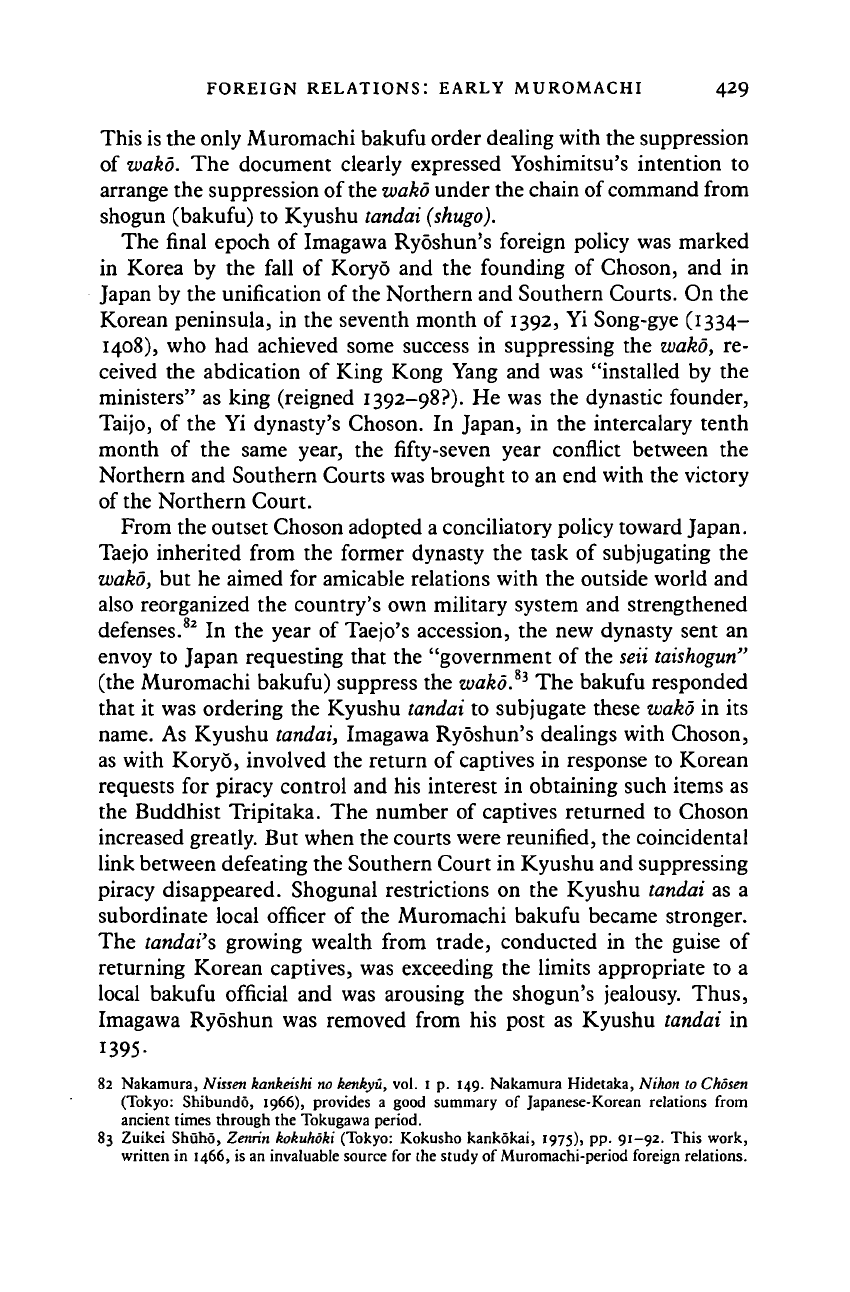
FOREIGN RELATIONS: EARLY MUROMACHI 429
This is the only Muromachi bakufu order dealing with the suppression
of wako. The document clearly expressed Yoshimitsu's intention to
arrange the suppression of the wako under the chain of command from
shogun (bakufu) to Kyushu tandai (shugo).
The final epoch of Imagawa Ryoshun's foreign policy was marked
in Korea by the fall of Koryo and the founding of Choson, and in
Japan by the unification of the Northern and Southern Courts. On the
Korean peninsula, in the seventh month of 1392, Yi Song-gye (1334-
1408),
who had achieved some success in suppressing the wako, re-
ceived the abdication of King Kong Yang and was "installed by the
ministers" as king (reigned 1392-98?). He was the dynastic founder,
Taijo,
of the Yi dynasty's Choson. In Japan, in the intercalary tenth
month of the same year, the fifty-seven year conflict between the
Northern and Southern Courts was brought to an end with the victory
of the Northern Court.
From the outset Choson adopted a conciliatory policy toward Japan.
Taejo inherited from the former dynasty the task of subjugating the
wako,
but he aimed for amicable relations with the outside world and
also reorganized the country's own military system and strengthened
defenses.
82
In the year of Taejo's accession, the new dynasty sent an
envoy to Japan requesting that the "government of the seii taishogun"
(the Muromachi bakufu) suppress the wako}
1
The bakufu responded
that it was ordering the Kyushu tandai to subjugate these wako in its
name. As Kyushu tandai, Imagawa Ryoshun's dealings with Choson,
as with Koryo, involved the return of captives in response to Korean
requests for piracy control and his interest in obtaining such items as
the Buddhist Tripitaka. The number of captives returned to Choson
increased greatly. But when the courts were reunified, the coincidental
link between defeating the Southern Court in Kyushu and suppressing
piracy disappeared. Shogunal restrictions on the Kyushu tandai as a
subordinate local officer of the Muromachi bakufu became stronger.
The tandai's growing wealth from trade, conducted in the guise of
returning Korean captives, was exceeding the limits appropriate to a
local bakufu official and was arousing the shogun's jealousy. Thus,
Imagawa Ryoshun was removed from his post as Kyushu tandai in
1395-
82 Nakamura, Nissen kankeishi no kenkyu, vol. I p. 149. Nakamura Hidecaka, Nihon to Chosen
(Tokyo: Shibundo, 1966), provides a good summary of Japanese-Korean relations from
ancient times through the Tokugawa period.
83 Zuikei Shuho, Zemin kokuhoki (Tokyo: Kokusho kankokai, 1975), pp. 91-92. This work,
written in 1466, is an invaluable source for the study of Muromachi-period foreign relations.
Cambridge Histories Online © Cambridge University Press, 2008
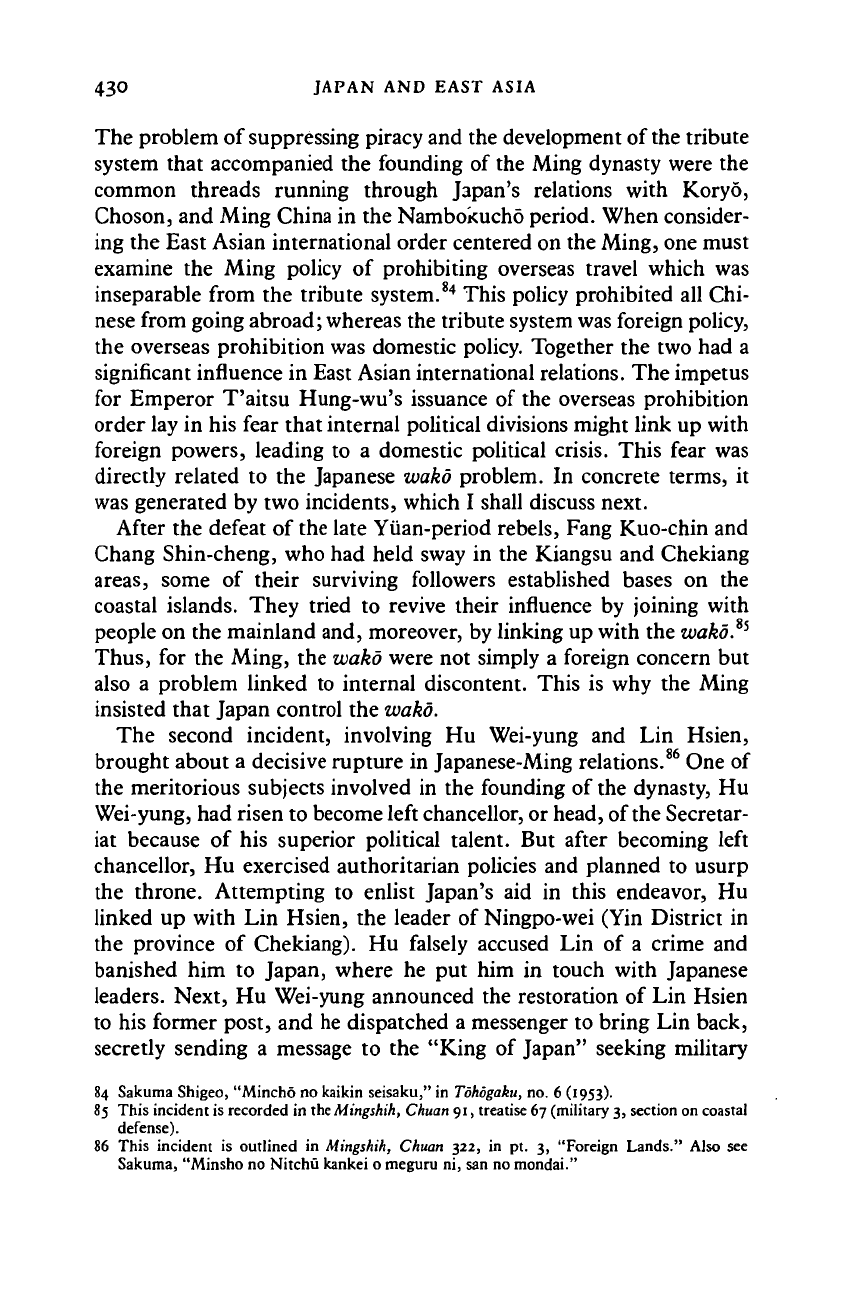
430 JAPAN AND EAST ASIA
The problem of suppressing piracy and the development of
the
tribute
system that accompanied the founding of the Ming dynasty were the
common threads running through Japan's relations with Koryo,
Choson, and Ming China in the Nambokucho period. When consider-
ing the East Asian international order centered on the Ming, one must
examine the Ming policy of prohibiting overseas travel which was
inseparable from the tribute system.
84
This policy prohibited all Chi-
nese from going abroad; whereas the tribute system
was
foreign policy,
the overseas prohibition was domestic policy. Together the two had a
significant influence in East Asian international relations. The impetus
for Emperor T'aitsu Hung-wu's issuance of the overseas prohibition
order lay in his fear that internal political divisions might link up with
foreign powers, leading to a domestic political crisis. This fear was
directly related to the Japanese wako problem. In concrete terms, it
was generated by two incidents, which I shall discuss next.
After the defeat of the late Yuan-period rebels, Fang Kuo-chin and
Chang Shin-cheng, who had held sway in the Kiangsu and Chekiang
areas,
some of their surviving followers established bases on the
coastal islands. They tried to revive their influence by joining with
people on the mainland and, moreover, by linking up with the
wakd.*
5
Thus,
for the Ming, the wako were not simply a foreign concern but
also a problem linked to internal discontent. This is why the Ming
insisted that Japan control the wako.
The second incident, involving Hu Wei-yung and Lin Hsien,
brought about a decisive rupture in Japanese-Ming relations.
86
One of
the meritorious subjects involved in the founding of the dynasty, Hu
Wei-yung, had risen to become left chancellor, or head, of the Secretar-
iat because of his superior political talent. But after becoming left
chancellor, Hu exercised authoritarian policies and planned to usurp
the throne. Attempting to enlist Japan's aid in this endeavor, Hu
linked up with Lin Hsien, the leader of Ningpo-wei (Yin District in
the province of Chekiang). Hu falsely accused Lin of a crime and
banished him to Japan, where he put him in touch with Japanese
leaders. Next, Hu Wei-yung announced the restoration of Lin Hsien
to his former post, and he dispatched a messenger to bring Lin back,
secretly sending a message to the "King of Japan" seeking military
84
Sakuma
Shigeo,
"Mincho no kaikin seisaku," in
Tohogaku,
no. 6
(1953).
85
This incident is recorded in the
Mingshih,
Chuan
91,
treatise 67 (military 3, section on coastal
defense).
86
This incident is outlined in
Mingshih,
Chuan 322, in pt. 3, "Foreign
Lands."
Also see
Sakuma,
"Minsho no Nitchu kankei o meguru ni, san no
mondai."
Cambridge Histories Online © Cambridge University Press, 2008
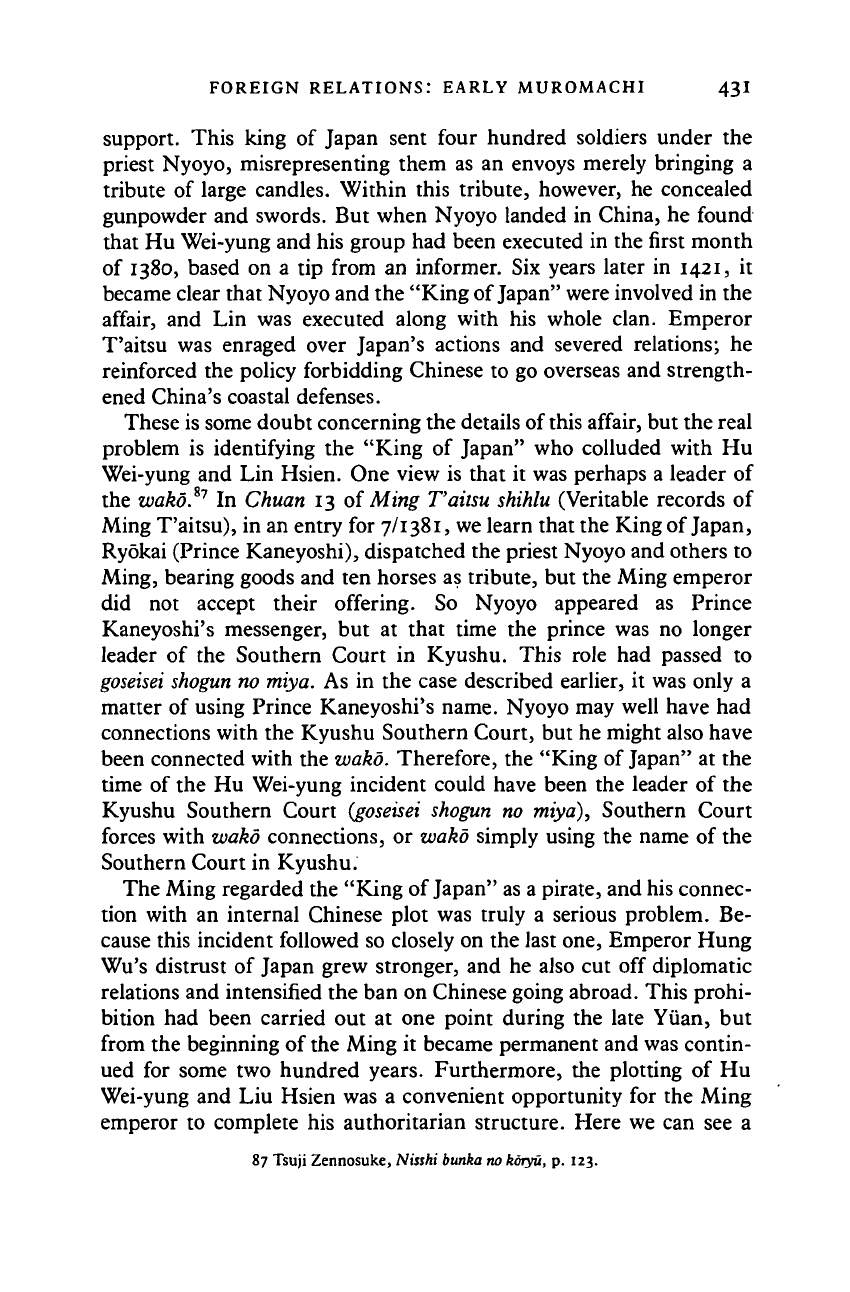
FOREIGN RELATIONS: EARLY MUROMACHI 43I
support. This king of Japan sent four hundred soldiers under the
priest Nyoyo, misrepresenting them as an envoys merely bringing a
tribute of large candles. Within this tribute, however, he concealed
gunpowder and swords. But when Nyoyo landed in China, he found
that Hu Wei-yung and his group had been executed in the first month
of 1380, based on a tip from an informer. Six years later in 1421, it
became clear that Nyoyo and the "King of Japan" were involved in the
affair, and Lin was executed along with his whole clan. Emperor
T'aitsu was enraged over Japan's actions and severed relations; he
reinforced the policy forbidding Chinese to go overseas and strength-
ened China's coastal defenses.
These is some doubt concerning the details of this affair, but the real
problem is identifying the "King of Japan" who colluded with Hu
Wei-yung and Lin Hsien. One view is that it was perhaps a leader of
the wako}
1
In Chuan 13 of Ming
T'aitsu
shihlu
(Veritable records of
Ming T'aitsu), in an entry for
7/1381,
we learn that the King of Japan,
Ryokai (Prince Kaneyoshi), dispatched the priest Nyoyo and others to
Ming, bearing goods and ten horses as tribute, but the Ming emperor
did not accept their offering. So Nyoyo appeared as Prince
Kaneyoshi's messenger, but at that time the prince was no longer
leader of the Southern Court in Kyushu. This role had passed to
goseisei shogun
no
miya.
As in the case described earlier, it was only a
matter of using Prince Kaneyoshi's name. Nyoyo may well have had
connections with the Kyushu Southern Court, but he might also have
been connected with the wako. Therefore, the "King of Japan" at the
time of the Hu Wei-yung incident could have been the leader of the
Kyushu Southern Court
(goseisei shogun
no miya), Southern Court
forces with wako connections, or wako simply using the name of the
Southern Court in Kyushu.
The Ming regarded the "King of
Japan"
as a pirate, and his connec-
tion with an internal Chinese plot was truly a serious problem. Be-
cause this incident followed so closely on the last one, Emperor Hung
Wu's distrust of Japan grew stronger, and he also cut off diplomatic
relations and intensified the ban on Chinese going abroad. This prohi-
bition had been carried out at one point during the late Yuan, but
from the beginning of the Ming it became permanent and was contin-
ued for some two hundred years. Furthermore, the plotting of Hu
Wei-yung and Liu Hsien was a convenient opportunity for the Ming
emperor to complete his authoritarian structure. Here we can see a
87 Tsuji Zennosuke, Nisshi bunka no koryu, p. 123.
Cambridge Histories Online © Cambridge University Press, 2008
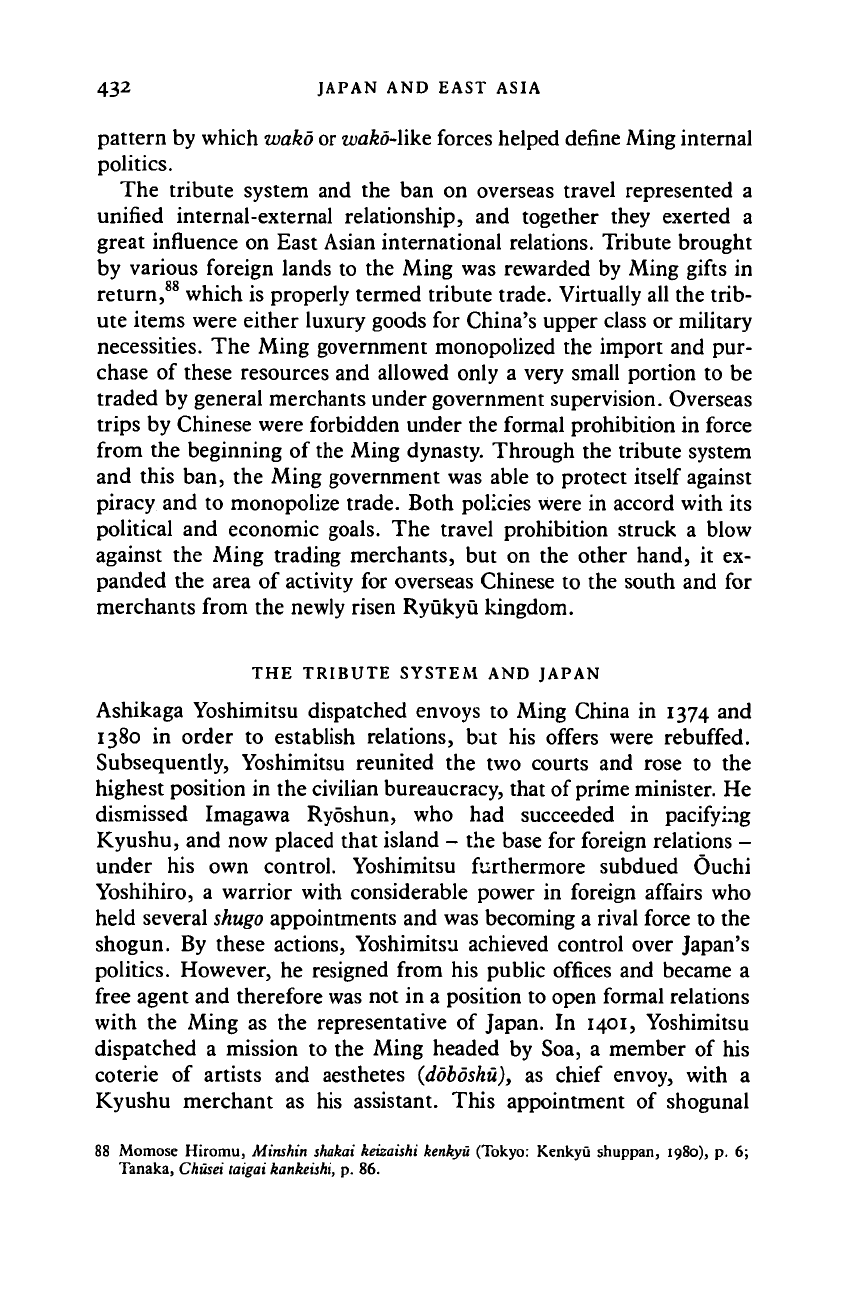
432 JAPAN AND EAST ASIA
pattern by which wako or
wakd-like
forces helped define Ming internal
politics.
The tribute system and the ban on overseas travel represented a
unified internal-external relationship, and together they exerted a
great influence on East Asian international relations. Tribute brought
by various foreign lands to the Ming was rewarded by Ming gifts in
return,
88
which is properly termed tribute trade. Virtually all the trib-
ute items were either luxury goods for China's upper class or military
necessities. The Ming government monopolized the import and pur-
chase of these resources and allowed only a very small portion to be
traded by general merchants under government supervision. Overseas
trips by Chinese were forbidden under the formal prohibition in force
from the beginning of the Ming dynasty. Through the tribute system
and this ban, the Ming government was able to protect itself against
piracy and to monopolize trade. Both policies were in accord with its
political and economic goals. The travel prohibition struck a blow
against the Ming trading merchants, but on the other hand, it ex-
panded the area of activity for overseas Chinese to the south and for
merchants from the newly risen Ryukyu kingdom.
THE TRIBUTE SYSTEM AND JAPAN
Ashikaga Yoshimitsu dispatched envoys to Ming China in 1374 and
1380 in order to establish relations, but his offers were rebuffed.
Subsequently, Yoshimitsu reunited the two courts and rose to the
highest position in the civilian bureaucracy, that of prime minister. He
dismissed Imagawa Ryoshun, who had succeeded in pacifying
Kyushu, and now placed that island - the base for foreign relations -
under his own control. Yoshimitsu furthermore subdued Ouchi
Yoshihiro, a warrior with considerable power in foreign affairs who
held several
shugo
appointments and was becoming a rival force to the
shogun. By these actions, Yoshimitsu achieved control over Japan's
politics. However, he resigned from his public offices and became a
free agent and therefore was not in a position to open formal relations
with the Ming as the representative of Japan. In 1401, Yoshimitsu
dispatched a mission to the Ming headed by Soa, a member of his
coterie of artists and aesthetes (doboshu), as chief envoy, with a
Kyushu merchant as his assistant. This appointment of shogunal
88 Momose Hiromu, Minshin shakai keizaishi kenkyu (Tokyo: Kenkyu shuppan, 1980), p. 6;
Tanaka, Chusei taigai kankeishi, p. 86.
Cambridge Histories Online © Cambridge University Press, 2008
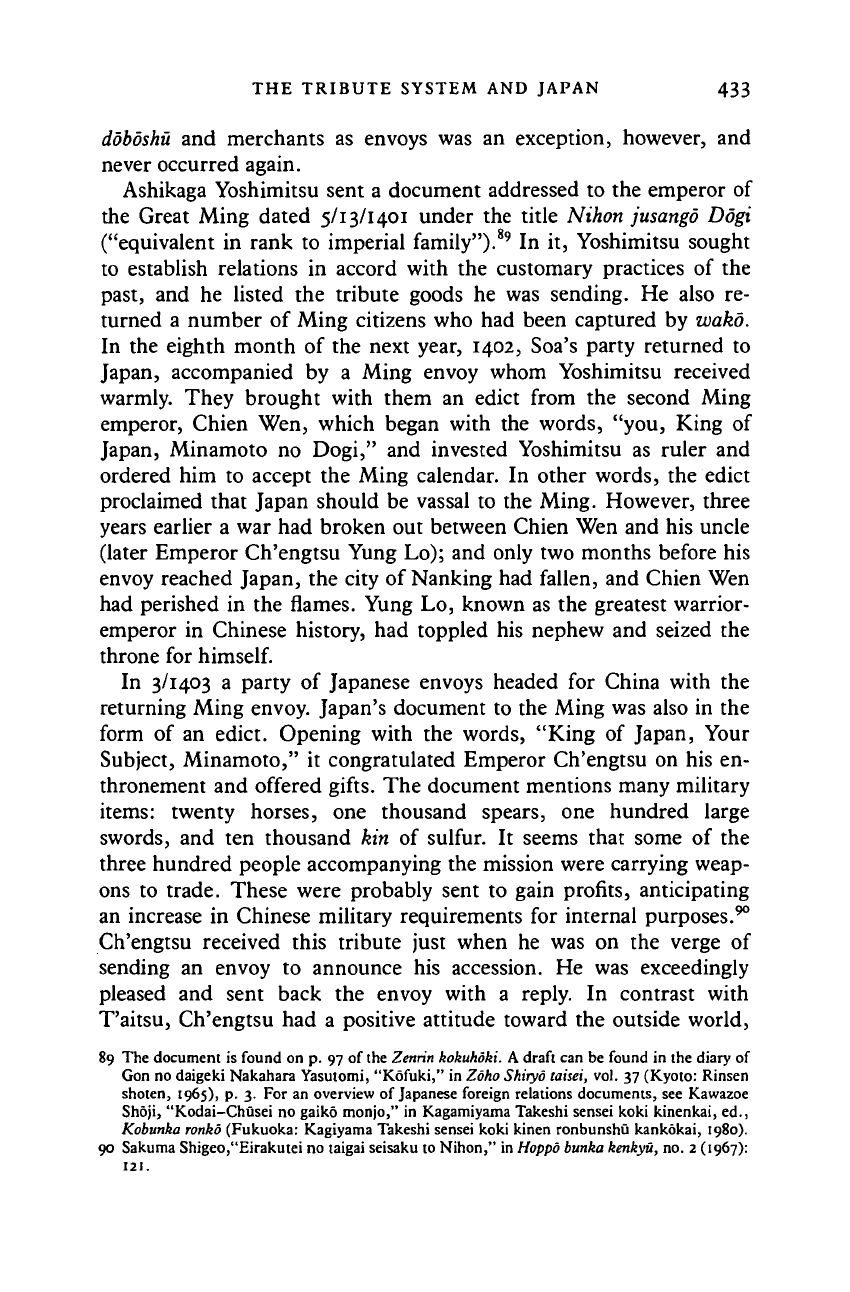
THE TRIBUTE SYSTEM AND JAPAN 433
doboshu and merchants as envoys was an exception, however, and
never occurred again.
Ashikaga Yoshimitsu sent a document addressed to the emperor of
the Great Ming dated 5/13/1401 under the title Nihon jusango Dogi
("equivalent in rank to imperial family")-
89
In it, Yoshimitsu sought
to establish relations in accord with the customary practices of the
past, and he listed the tribute goods he was sending. He also re-
turned a number of Ming citizens who had been captured by wako.
In the eighth month of the next year, 1402, Soa's party returned to
Japan, accompanied by a Ming envoy whom Yoshimitsu received
warmly. They brought with them an edict from the second Ming
emperor, Chien Wen, which began with the words, "you, King of
Japan, Minamoto no Dogi," and invested Yoshimitsu as ruler and
ordered him to accept the Ming calendar. In other words, the edict
proclaimed that Japan should be vassal to the Ming. However, three
years earlier a war had broken out between Chien Wen and his uncle
(later Emperor Ch'engtsu Yung Lo); and only two months before his
envoy reached Japan, the city of Nanking had fallen, and Chien Wen
had perished in the flames. Yung Lo, known as the greatest warrior-
emperor in Chinese history, had toppled his nephew and seized the
throne for
himself.
In 3/1403 a party of Japanese envoys headed for China with the
returning Ming envoy. Japan's document to the Ming was also in the
form of an edict. Opening with the words, "King of Japan, Your
Subject, Minamoto," it congratulated Emperor Ch'engtsu on his en-
thronement and offered gifts. The document mentions many military
items:
twenty horses, one thousand spears, one hundred large
swords, and ten thousand kin of sulfur. It seems that some of the
three hundred people accompanying the mission were carrying weap-
ons to trade. These were probably sent to gain profits, anticipating
an increase in Chinese military requirements for internal purposes.
90
Ch'engtsu received this tribute just when he was on the verge of
sending an envoy to announce his accession. He was exceedingly
pleased and sent back the envoy with a reply. In contrast with
T'aitsu, Ch'engtsu had a positive attitude toward the outside world,
89 The document is found on p. 97 of the Zemin kokuhoki. A draft can be found in the diary of
Gon no daigeki Nakahara Yasutomi, "Kofuki," in Zoho Shiryo taisei, vol. 37 (Kyoto: Rinsen
shoten, 1965), p. 3. For an overview of Japanese foreign relations documents, see Kawazoe
Shoji, "Kodai-Chusei no gaiko monjo," in Kagamiyama Takeshi sensei koki kinenkai, ed.,
Kobunka ronko (Fukuoka: Kagiyama Takeshi sensei koki kinen ronbunshu kankokai, 1980).
90 Sakuma Shigeo/'Eirakutei no taigai seisaku to Nihon," in Hoppb bunka kenkyu, no. 2 (1967):
121.
Cambridge Histories Online © Cambridge University Press, 2008
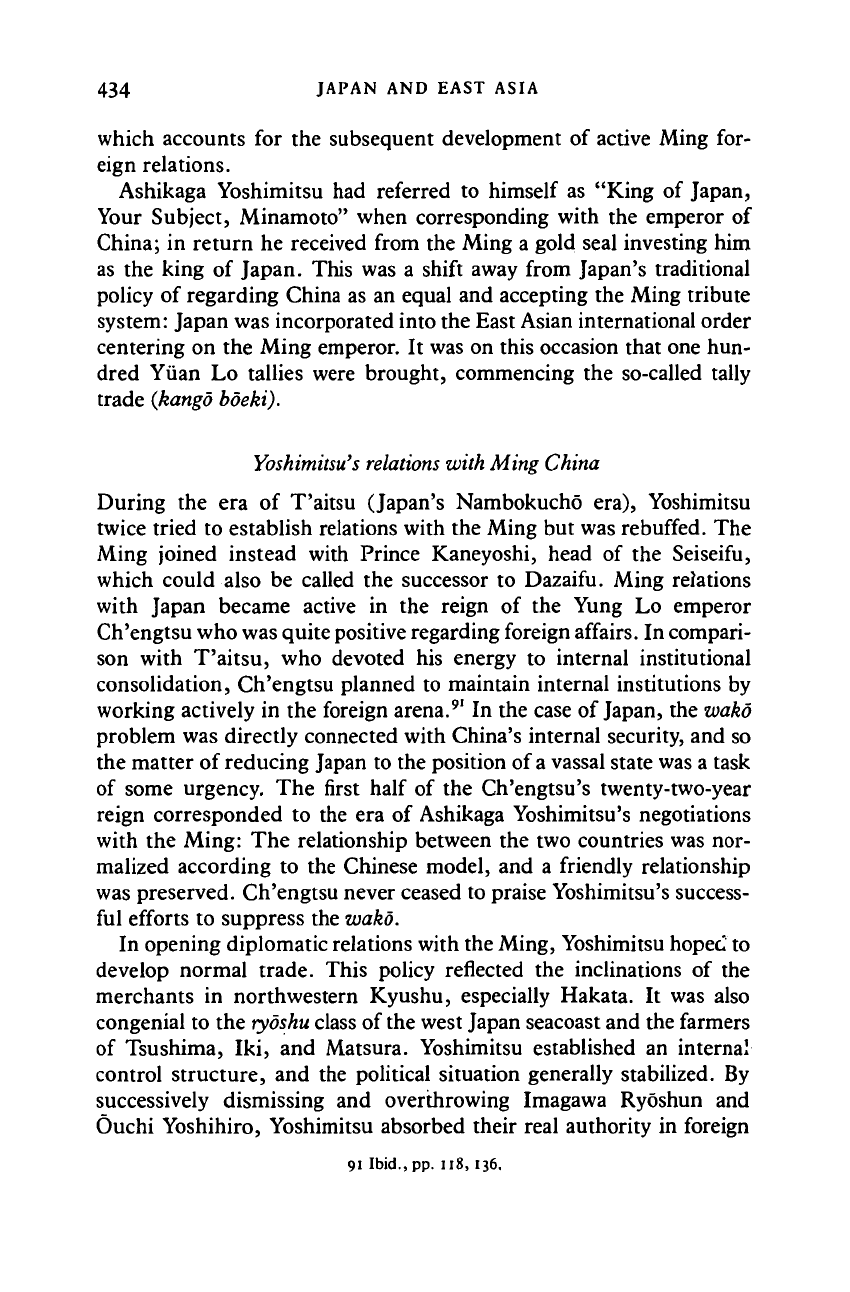
434 JAPAN AND EAST ASIA
which accounts for the subsequent development of active Ming for-
eign relations.
Ashikaga Yoshimitsu had referred to himself as "King of Japan,
Your Subject, Minamoto" when corresponding with the emperor of
China; in return he received from the Ming a gold seal investing him
as the king of Japan. This was a shift away from Japan's traditional
policy of regarding China as an equal and accepting the Ming tribute
system: Japan was incorporated into the East Asian international order
centering on the Ming emperor. It was on this occasion that one hun-
dred Yuan Lo tallies were brought, commencing the so-called tally
trade
(kango
boeki).
Yoshimitsu's relations with
Ming
China
During the era of T'aitsu (Japan's Nambokucho era), Yoshimitsu
twice tried to establish relations with the Ming but was rebuffed. The
Ming joined instead with Prince Kaneyoshi, head of the Seiseifu,
which could also be called the successor to Dazaifu. Ming relations
with Japan became active in the reign of the Yung Lo emperor
Ch'engtsu who was quite positive regarding foreign affairs. In compari-
son with T'aitsu, who devoted his energy to internal institutional
consolidation, Ch'engtsu planned to maintain internal institutions by
working actively in the foreign arena.
91
In the case of Japan, the wako
problem was directly connected with China's internal security, and so
the matter of reducing Japan to the position of
a
vassal state was a task
of some urgency. The first half of the Ch'engtsu's twenty-two-year
reign corresponded to the era of Ashikaga Yoshimitsu's negotiations
with the Ming: The relationship between the two countries was nor-
malized according to the Chinese model, and a friendly relationship
was preserved. Ch'engtsu never ceased to praise Yoshimitsu's success-
ful efforts to suppress the wako.
In opening diplomatic relations with the Ming, Yoshimitsu hoped to
develop normal trade. This policy reflected the inclinations of the
merchants in northwestern Kyushu, especially Hakata. It was also
congenial to the
ryoshu
class of
the
west Japan seacoast and the farmers
of Tsushima, Iki, and Matsura. Yoshimitsu established an internal
control structure, and the political situation generally stabilized. By
successively dismissing and overthrowing Imagawa Ryoshun and
Ouchi Yoshihiro, Yoshimitsu absorbed their real authority in foreign
91 Ibid., pp. 118, 136.
Cambridge Histories Online © Cambridge University Press, 2008
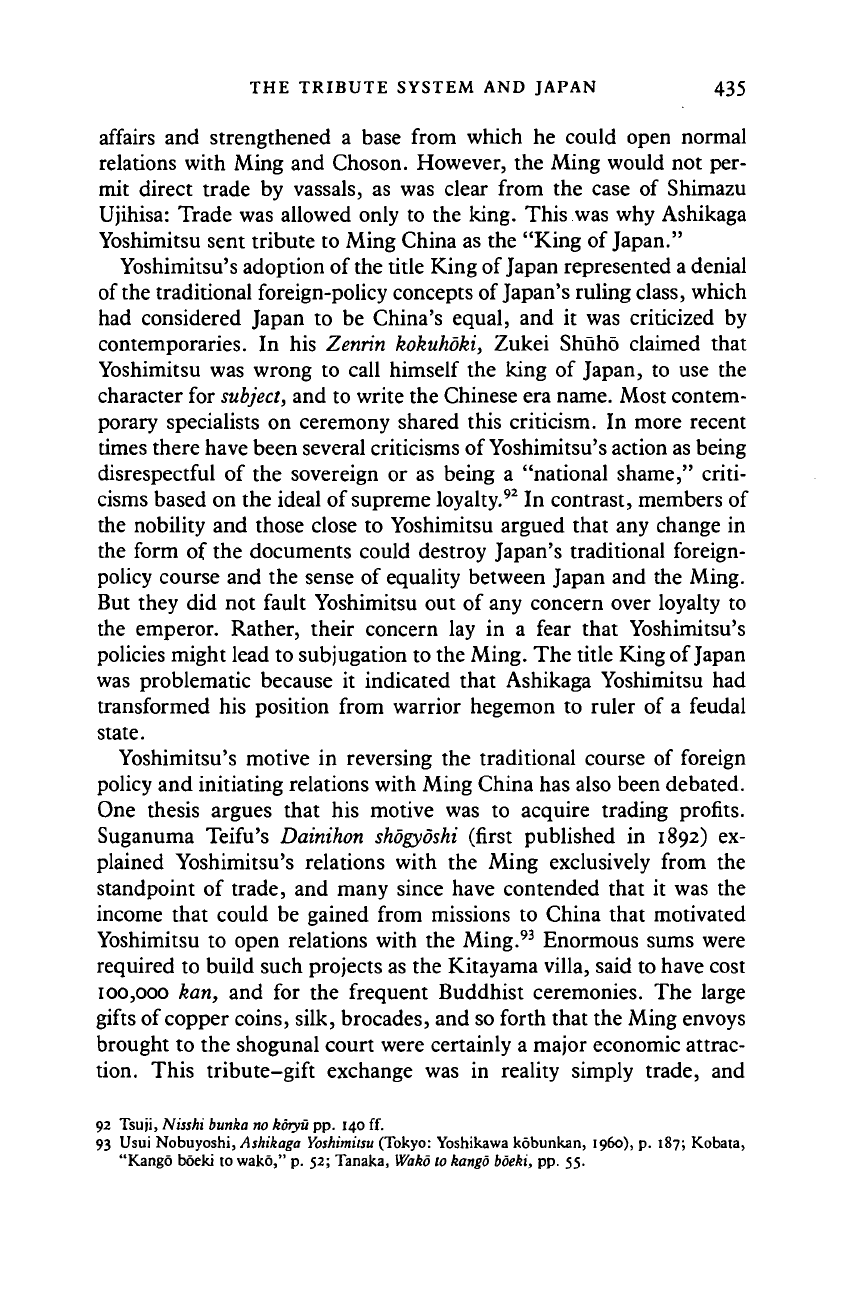
THE TRIBUTE SYSTEM AND JAPAN 435
affairs and strengthened a base from which he could open normal
relations with Ming and Choson. However, the Ming would not per-
mit direct trade by vassals, as was clear from the case of Shimazu
Ujihisa: Trade was allowed only to the king. This was why Ashikaga
Yoshimitsu sent tribute to Ming China as the "King of Japan."
Yoshimitsu's adoption of the title King of Japan represented a denial
of the traditional foreign-policy concepts of Japan's ruling class, which
had considered Japan to be China's equal, and it was criticized by
contemporaries. In his Zenrin kokuhoki, Zukei Shuho claimed that
Yoshimitsu was wrong to call himself the king of Japan, to use the
character for
subject,
and to write the Chinese era name. Most contem-
porary specialists on ceremony shared this criticism. In more recent
times there have been several criticisms of Yoshimitsu's action as being
disrespectful of the sovereign or as being a "national shame," criti-
cisms based on the ideal of supreme loyalty.
92
In contrast, members of
the nobility and those close to Yoshimitsu argued that any change in
the form of the documents could destroy Japan's traditional foreign-
policy course and the sense of equality between Japan and the Ming.
But they did not fault Yoshimitsu out of any concern over loyalty to
the emperor. Rather, their concern lay in a fear that Yoshimitsu's
policies might lead to subjugation to the Ming. The title King of Japan
was problematic because it indicated that Ashikaga Yoshimitsu had
transformed his position from warrior hegemon to ruler of a feudal
state.
Yoshimitsu's motive in reversing the traditional course of foreign
policy and initiating relations with Ming China has also been debated.
One thesis argues that his motive was to acquire trading profits.
Suganuma Teifu's Dainihon shdgyoshi (first published in 1892) ex-
plained Yoshimitsu's relations with the Ming exclusively from the
standpoint of trade, and many since have contended that it was the
income that could be gained from missions to China that motivated
Yoshimitsu to open relations with the Ming.
93
Enormous sums were
required to build such projects as the Kitayama villa, said to have cost
100,000 kan, and for the frequent Buddhist ceremonies. The large
gifts of copper coins, silk, brocades, and so forth that the Ming envoys
brought to the shogunal court were certainly a major economic attrac-
tion. This tribute-gift exchange was in reality simply trade, and
92 Tsuji, Nisshi bunka no koryu pp. 140 ff.
93 Usui Nobuyoshi, Ashikaga
Yoshimitsu
(Tokyo: Yoshikawa kobunkan, 1960), p. 187; Kobata,
"Kango boeki to wako," p. 52; Tanaka, Wako to kango boeki, pp. 55.
Cambridge Histories Online © Cambridge University Press, 2008
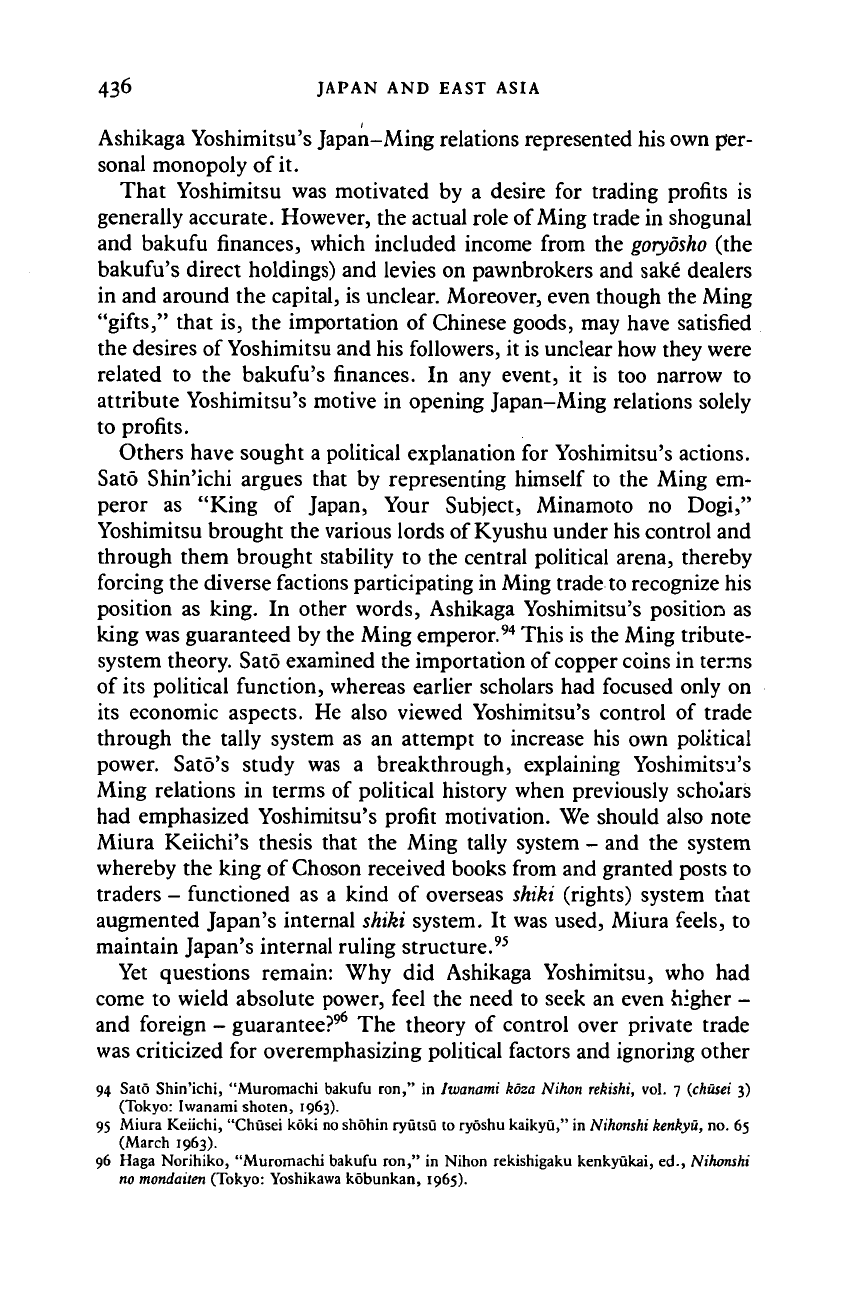
436 JAPAN AND EAST ASIA
Ashikaga Yoshimitsu's Japan-Ming relations represented his own per-
sonal monopoly of it.
That Yoshimitsu was motivated by a desire for trading profits is
generally accurate. However, the actual role of Ming trade in shogunal
and bakufu finances, which included income from the
goryosho
(the
bakufu's direct holdings) and levies on pawnbrokers and sake dealers
in and around the capital, is unclear. Moreover, even though the Ming
"gifts,"
that is, the importation of Chinese goods, may have satisfied
the desires of Yoshimitsu and his followers, it is unclear how they were
related to the bakufu's finances. In any event, it is too narrow to
attribute Yoshimitsu's motive in opening Japan-Ming relations solely
to profits.
Others have sought a political explanation for Yoshimitsu's actions.
Sato Shin'ichi argues that by representing himself to the Ming em-
peror as "King of Japan, Your Subject, Minamoto no Dogi,"
Yoshimitsu brought the various lords of Kyushu under his control and
through them brought stability to the central political arena, thereby
forcing the diverse factions participating in Ming trade to recognize his
position as king. In other words, Ashikaga Yoshimitsu's position as
king was guaranteed by the Ming emperor.
94
This is the Ming tribute-
system theory. Sato examined the importation of copper coins in terms
of its political function, whereas earlier scholars had focused only on
its economic aspects. He also viewed Yoshimitsu's control of trade
through the tally system as an attempt to increase his own political
power. Sato's study was a breakthrough, explaining Yoshimitsu's
Ming relations in terms of political history when previously scholars
had emphasized Yoshimitsu's profit motivation. We should also note
Miura Keiichi's thesis that the Ming tally system - and the system
whereby the king of Choson received books from and granted posts to
traders - functioned as a kind of overseas shiki (rights) system that
augmented Japan's internal shiki system. It was used, Miura feels, to
maintain Japan's internal ruling structure.
95
Yet questions remain: Why did Ashikaga Yoshimitsu, who had
come to wield absolute power, feel the need to seek an even higher -
and foreign - guarantee?
96
The theory of control over private trade
was criticized for overemphasizing political factors and ignoring other
94 Sato Shin'ichi, "Muromachi bakufu ron," in Iwanami koza Nihon rekishi, vol. 7 (chitsei 3)
(Tokyo: Iwanami shocen, 1963).
95 Miura Keiichi, "Chusei koki no shohin ryutsu to ryoshu kaikyu," in Nihonshi kenkyu, no. 65
(March 1963).
96 Haga Norihiko, "Muromachi bakufu ron," in Nihon rekishigaku kenkyukai, ed., Nihonshi
no mondaiten (Tokyo: Yoshikawa kobunkan, 1965).
Cambridge Histories Online © Cambridge University Press, 2008
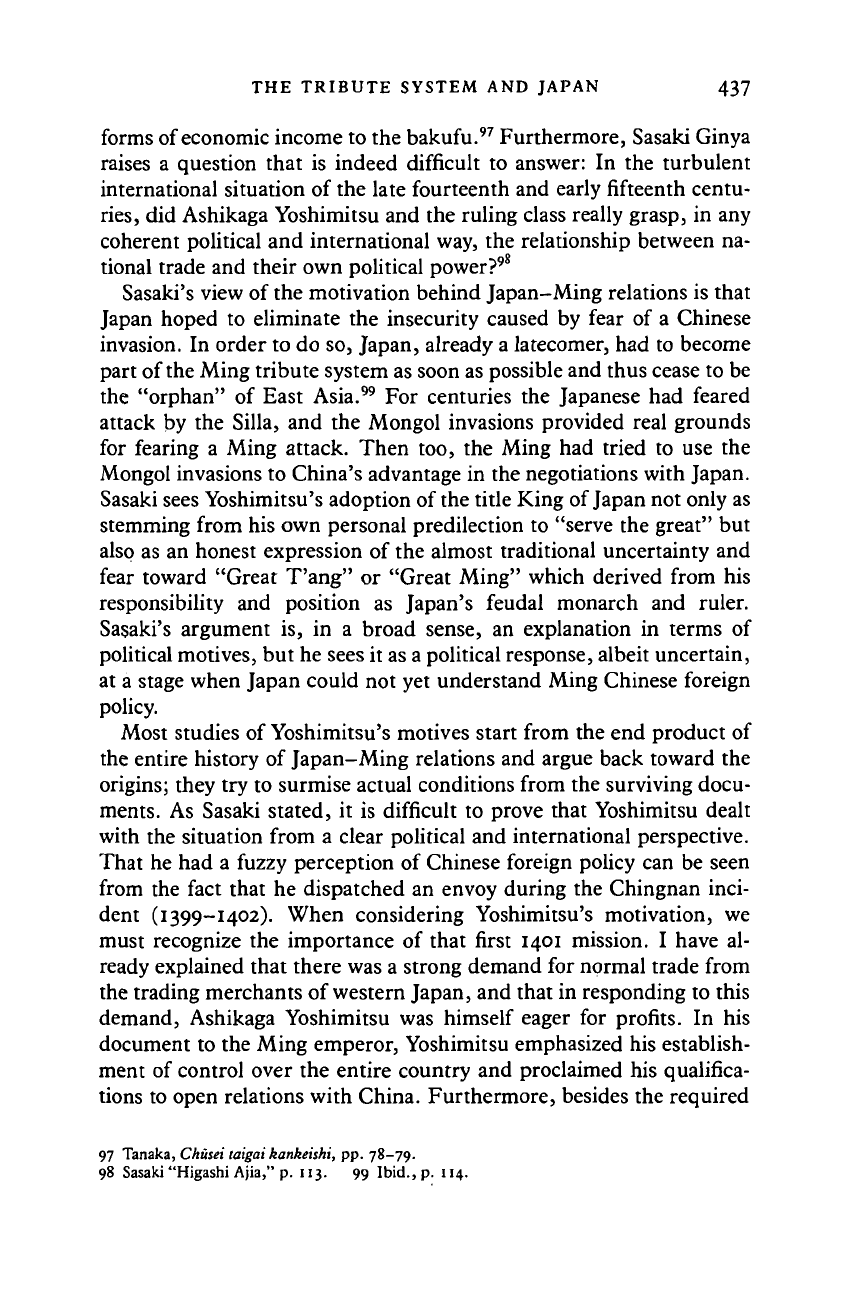
THE TRIBUTE SYSTEM AND JAPAN 437
forms of economic income to the bakufu.
97
Furthermore, Sasaki Ginya
raises a question that is indeed difficult to answer: In the turbulent
international situation of the late fourteenth and early fifteenth centu-
ries, did Ashikaga Yoshimitsu and the ruling class really grasp, in any
coherent political and international way, the relationship between na-
tional trade and their own political power?
98
Sasaki's view of the motivation behind Japan-Ming relations is that
Japan hoped to eliminate the insecurity caused by fear of a Chinese
invasion. In order to do so, Japan, already a latecomer, had to become
part of the Ming tribute system as soon as possible and thus cease to be
the "orphan" of East Asia.
99
For centuries the Japanese had feared
attack by the Silla, and the Mongol invasions provided real grounds
for fearing a Ming attack. Then too, the Ming had tried to use the
Mongol invasions to China's advantage in the negotiations with Japan.
Sasaki sees Yoshimitsu's adoption of the title King of Japan not only as
stemming from his own personal predilection to "serve the great" but
also as an honest expression of the almost traditional uncertainty and
fear toward "Great T'ang" or "Great Ming" which derived from his
responsibility and position as Japan's feudal monarch and ruler.
Sasaki's argument is, in a broad sense, an explanation in terms of
political motives, but he sees it as a political response, albeit uncertain,
at a stage when Japan could not yet understand Ming Chinese foreign
policy.
Most studies of Yoshimitsu's motives start from the end product of
the entire history of Japan-Ming relations and argue back toward the
origins; they try to surmise actual conditions from the surviving docu-
ments. As Sasaki stated, it is difficult to prove that Yoshimitsu dealt
with the situation from a clear political and international perspective.
That he had a fuzzy perception of Chinese foreign policy can be seen
from the fact that he dispatched an envoy during the Chingnan inci-
dent (1399-1402). When considering Yoshimitsu's motivation, we
must recognize the importance of that first 1401 mission. I have al-
ready explained that there was a strong demand for normal trade from
the trading merchants of western Japan, and that in responding to this
demand, Ashikaga Yoshimitsu was himself eager for profits. In his
document to the Ming emperor, Yoshimitsu emphasized his establish-
ment of control over the entire country and proclaimed his qualifica-
tions to open relations with China. Furthermore, besides the required
97 Tanaka, Chusei taigai kankeishi, pp. 78-79.
98 Sasaki "Higashi Ajia," p. 113. 99 Ibid., p. 114.
Cambridge Histories Online © Cambridge University Press, 2008
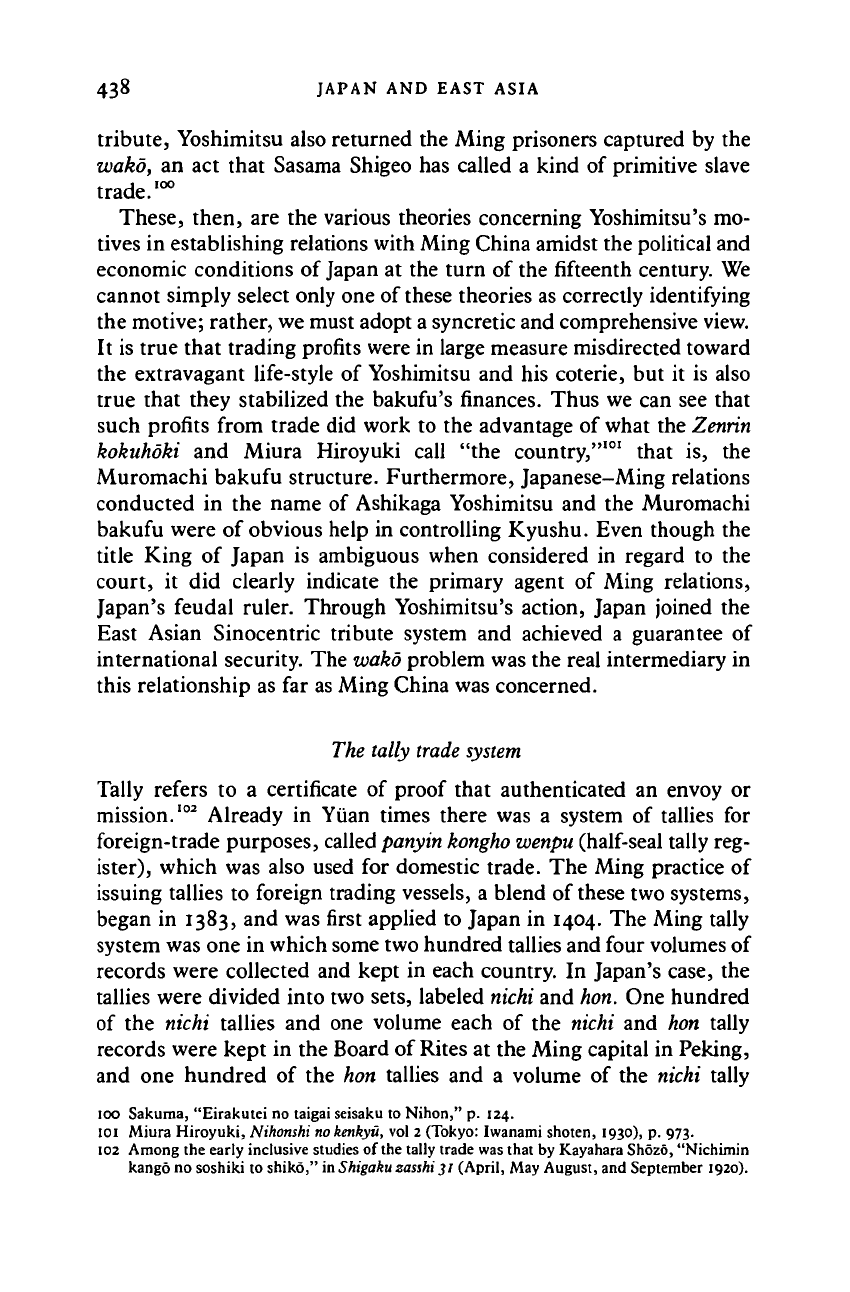
438 JAPAN AND EAST ASIA
tribute, Yoshimitsu also returned the Ming prisoners captured by the
wako,
an act that Sasama Shigeo has called a kind of primitive slave
trade.
100
These, then, are the various theories concerning Yoshimitsu's mo-
tives in establishing relations with Ming China amidst the political and
economic conditions of Japan at the turn of the fifteenth century. We
cannot simply select only one of these theories as correctly identifying
the motive; rather, we must adopt a syncretic and comprehensive view.
It is true that trading profits were in large measure misdirected toward
the extravagant life-style of Yoshimitsu and his coterie, but it is also
true that they stabilized the bakufu's finances. Thus we can see that
such profits from trade did work to the advantage of what the Zemin
kokuhoki and Miura Hiroyuki call "the country,"
101
that is, the
Muromachi bakufu structure. Furthermore, Japanese-Ming relations
conducted in the name of Ashikaga Yoshimitsu and the Muromachi
bakufu were of obvious help in controlling Kyushu. Even though the
title King of Japan is ambiguous when considered in regard to the
court, it did clearly indicate the primary agent of Ming relations,
Japan's feudal ruler. Through Yoshimitsu's action, Japan joined the
East Asian Sinocentric tribute system and achieved a guarantee of
international security. The wako problem was the real intermediary in
this relationship as far as Ming China was concerned.
The tally trade system
Tally refers to a certificate of proof that authenticated an envoy or
mission.
102
Already in Yuan times there was a system of tallies for
foreign-trade purposes, called panyin kongho wenpu (half-seal tally reg-
ister),
which was also used for domestic trade. The Ming practice of
issuing tallies to foreign trading vessels, a blend of these two systems,
began in 1383, and was first applied to Japan in 1404. The Ming tally
system was one in which some two hundred tallies and four volumes of
records were collected and kept in each country. In Japan's case, the
tallies were divided into two sets, labeled nichi and hon. One hundred
of the nichi tallies and one volume each of the nichi and hon tally
records were kept in the Board of Rites at the Ming capital in Peking,
and one hundred of the hon tallies and a volume of the nichi tally
100 Sakuma, "Eirakutei no taigai seisaku to Nihon," p. 124.
101 Miura Hiroyuki, Nihonshi no kenhyii, vol 2 (Tokyo: Iwanami shoten, 1930), p. 973.
102 Among the early inclusive studies of the tally trade was that by Kayahara Shozo, "Nichimin
kango no soshiki to shiko," in Shigaku zasshi31 (April, May August, and September 1920).
Cambridge Histories Online © Cambridge University Press, 2008
